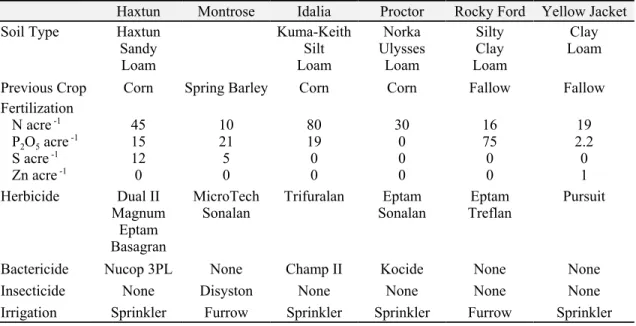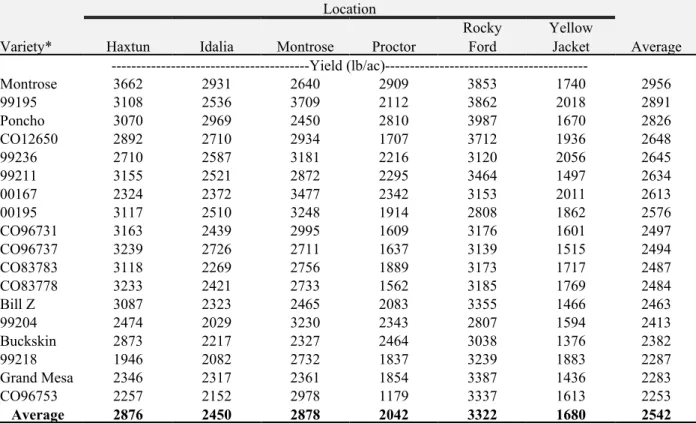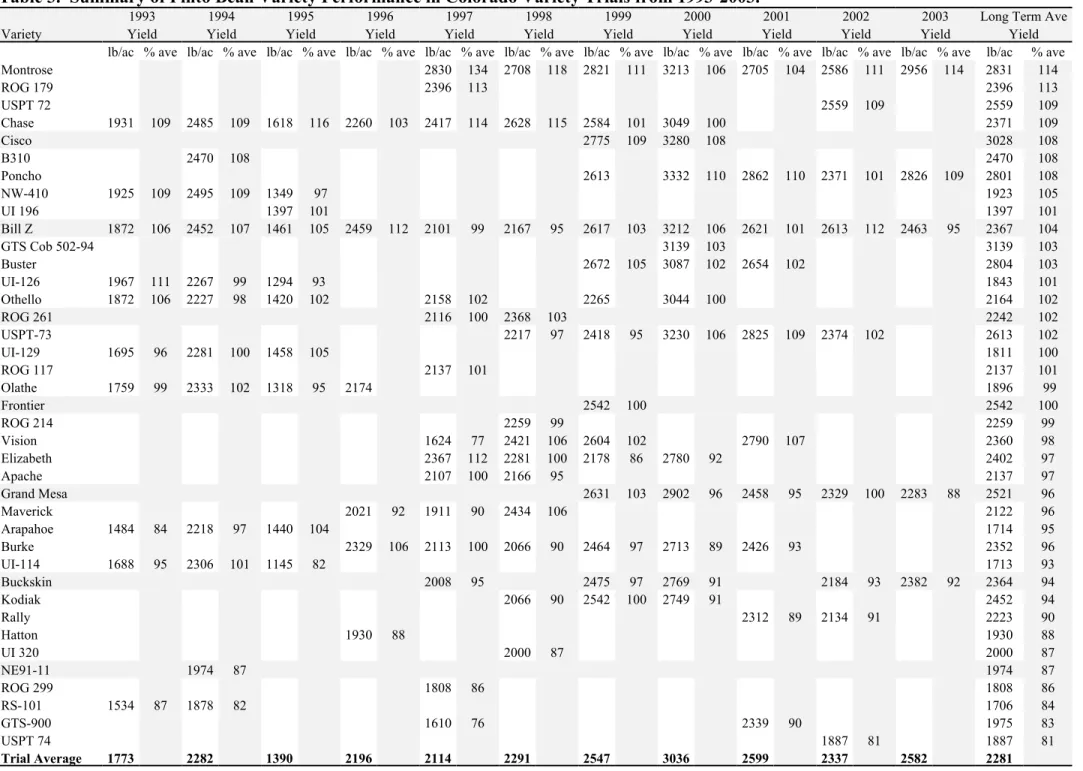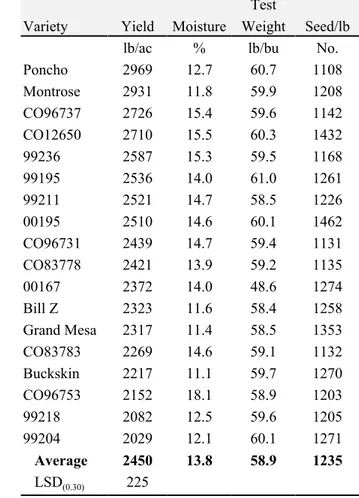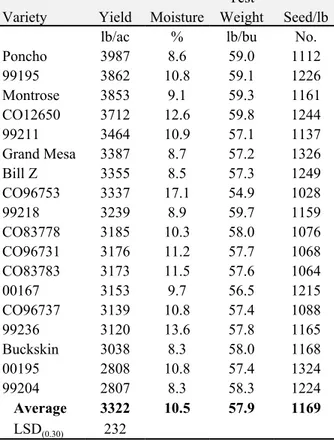Cooperative Extension
Colorado State UniversityMAKING BETTER
DECISIONS
2003 Dry Bean Variety Performance Trials
Agricultural Experiment Station
Colorado State University, U.S. Department of Agriculture and Colorado counties cooperating. Cooperative Extension programs
Rocky Ford
Yellow Jacket
Montrose
Six Colorado Pinto Bean Trial Locations in 2003 Weld(2) 374,000 Kit Carson 99,000 Yuma(1) 383,000 Phillips(5) 110,000 Sedgwick(4) 128,000 Morgan 71,000 Montrose(3) 129,000 Dolores 3,000
2002 production (cwt) for the highest producing counties in Colorado.
Idalia Proctor Larimer 32,000 58,000Logan Otero 11,000 Boulder 12,000 Adams 6,000 Washington 13,000 Pueblo 43,000 Montezuma Mesa 12,000 26,000Delta Haxtun Cheyenne 9,000 Denver Rocky Ford Yellow Jacket Montrose
Six Colorado Pinto Bean Trial Locations in 2003 Weld(2) 374,000 Kit Carson 99,000 Yuma(1) 383,000 Phillips(5) 110,000 Sedgwick(4) 128,000 Morgan 71,000 Montrose(3) 129,000 Dolores 3,000
2002 production (cwt) for the highest producing counties in Colorado.
Idalia Proctor Larimer 32,000 58,000Logan Otero 11,000 Boulder 12,000 Adams 6,000 Washington 13,000 Pueblo 43,000 Montezuma Mesa 12,000 26,000Delta Haxtun Cheyenne 9,000 Denver
KNOW YOUR DRY BEAN IMPROVEMENT TEAM
Dr. Jerry J. Johnson, Extension Crop Production (970) 491-1454 jjj@lamar.colostate.edu
Dr. Howard F. Schwartz, Extension Plant Pathology (970) 491-6987 Howard.Schwartz@colostate.edu
Dr. Mark A. Brick, Plant Breeding Program (970) 491-6551 mbrick@lamar.colostate.edu
Dr. Frank C. Schweissing, Arkansas Valley Research Center (719) 254-6312 fschwei@ria.net
Dr. Calvin H. Pearson, Western Colorado Research Center (970) 858-3629calvin.pearson@colostate.edu
Mark Stack, Southwestern Research Center (970) 562-4255 swcaes@coop.ext.colostate.edu
James P. Hain, Crops Testing Program (970) 544-0980
Cynthia L. Johnson, Crops Testing Program (970) 491-1914 cjohnson@agsci.colostate.edu
Mark M. McMillian, Bioag. Sci. & Pest Mgmt. (970) 491-7846 msmcm@lamar.colostate.edu
Dr. Scott J. Nissen, Extension Weed Science Specialist (970) 491-3489 snissen@larmar.colostate.edu
J. Barry Ogg, Plant Breeding Program (970) 491-6354 beans@lamar.colostate.edu
Kris Otto, Plant Pathology (970) 491-0256 kotto@lamar.colostate.edu
ACKNOWLEDGMENTS
The authors wish to express their gratitude to the Colorado farmers who generously contributed the use of their land, equipment, and time to conduct these trials for the benefit of all Colorado dry bean producers and bean dealers: Idalia - Dennis Towns; Haxtun - Steve Smith; Proctor - Bob Duncan and Montrose - Keith Catlin. We also acknowledge the participation of Colorado Experiment Stations at; Fruita (Western Colorado Research Center); Rocky Ford (Arkansas Valley Research Center) and Yellow Jacket (Southwestern Colorado Research Center). The success of the 2003 season is due in part to efforts of Colorado Cooperative Extension agents’ Ron Meyer (Golden Plains) and Bruce Bosley (Logan County); with research support provided by The Colorado Dry Bean Administrative Committee, and
i
Technical Report TR 03-09
Agricultural Department of Cooperative December
Experiment Soil and Crop Extension 2003
Station Sciences
TABLE OF CONTENTS
Introduction . . . 1
Cultural Conditions for Trials Table 1 . . . 1
Pinto Bean Varietal Descriptions . . . 2
Pinto Bean Performance Summaries and Trial Results Pinto Summaries Table 2-3 . . . 3
Haxtun Table 4 . . . 5
Idalia Table 5 . . . 5
Montrose Table 6 . . . 6
Proctor Table 7 . . . 6
Rocky Ford Table 8 . . . 7
Yellow Jacket Table 9 . . . 7
Special Market Class Varietal Descriptions . . . 7
Special Market Class Performance Trial Results Idalia Table 10-12 . . . 8
Potential Risk of Bean Diseases in Colorado by Geographical Region, Howard F. Schwartz. . . 8
CoAgMet Weather Data Summary, Howard F. Schwartz and Mark S. McMillan . . . 9
Dry Bean Variety Disease Observations, Howard F. Schwartz . . . 10
2003 COLORADO DRY BEAN PERFORMANCE TRIALS
Introduction
Dry bean acreage and production have declined in Colorado over the last ten years. In 2002, Colorado was the seventh largest producer of dry beans in the United States with the lowest product since 1921. In 2003, area harvested declined to only 69,000 acres; presumably due to continued drought effects in southwest Colorado and water problems (i.e., water access) in eastern Colorado. Nevertheless, Colorado producers annually spend millions of dollars on pinto bean seed which makes variety selection important. Colorado State University’s Crops Testing program, bean breeding program, bean pathology research, and three agricultural research stations collaborate to conduct six uniform variety trials annually to provide unbiased and reliable variety performance results from uniform variety trials to help Colorado dry bean producers’ make better variety decisions. The uniform variety trial serves a dual purpose of screening experimental lines from CSU's bean breeding program, or from bean seed companies, and to compare commercial variety performance for making variety recommendations to Colorado bean producers. The uniform variety trial is made possible by funding received from Colorado dry bean producers and handlers via the
Colorado Dry Bean Administrative Committee. Funding from the Colorado Bean Network makes it possible to publish the variety performance results in annual reports.
The 2003 uniform variety trials were planted at six locations for the fifth year. They were planted at four eastern Colorado trial locations including: Proctor (Platte River Valley), Haxtun, Idalia (Golden Plains), and Rocky Ford, (Arkansas River Valley) and two western Colorado locations: Montrose and Yellow Jacket. Varieties tested in 2003 are described in the tables below. A
randomized complete block field design with three replicates was used in all trials. The seeding rate was approximately 85,120 seeds per acre with plots consisting of four 30-inch rows and 36 feet long. All trials were in commercial bean fields or on CSU research stations. Seed yields, in pounds per acre, are adjusted to 14% moisture content. The disease profile was different this year than in the past. Rust and White Mold were not evident in the trials but, as seen in Table 1 bean diseases, Common Bacterial Blight, Bacterial Brown Spot, Fusarium Wilt, and Bean Common Mosaic Virus were found with varying degrees of severity at Proctor, Haxtun, and Idalia.
Table 1. Cultural conditions for trials in 2003.
Haxtun Montrose Idalia Proctor Rocky Ford Yellow Jacket Soil Type Haxtun
Sandy Loam Kuma-Keith Silt Loam Norka Ulysses Loam Silty Clay Loam Clay Loam Previous Crop Corn Spring Barley Corn Corn Fallow Fallow Fertilization N acre -1 P2O5 acre -1 S acre -1 Zn acre -1 45 15 12 0 10 21 5 0 80 19 0 0 30 0 0 0 16 75 0 0 19 2.2 0 1 Herbicide Dual II Magnum Eptam Basagran MicroTech
Sonalan Trifuralan SonalanEptam TreflanEptam Pursuit Bactericide Nucop 3PL None Champ II Kocide None None
Insecticide None Disyston None None None None
2
Pinto Bean Varietal Descriptions:
Bill Z A medium maturity (95 d) variety released by Colorado State University in 1985. It has a vine Type III growth habit with
resistance to bean common mosaic virus and moderate tolerance to bacterial brown spot. It is a very productive variety with excellent seed quality. However, it is susceptible to white mold, common bacterial blight and rust.
Buckskin A variety released by Syngenta Seeds, Inc. (RNK101). It is a vine Type III growth habit with
resistance to bean common mosaic virus, but is susceptible to white mold, rust, and bacterial brown spot with early to medium maturity (92 d).
CO12650 An experimental line from Colorado State University.
CO83778 An experimental line from Colorado State University.
CO83783 An experimental line from Colorado State University.
CO96731 An experimental line from Colorado State University.
CO96737 An experimental line from Colorado State University.
CO96753 An experimental line from Colorado State University.
Grand Mesa A medium maturity (96 d) variety from Colorado State University released in 2001. Grand Mesa combines resistance to rust, bean common mosaic virus, semi-upright Type II plant architecture and field tolerance to white mold, but is susceptible to common bacterial blight and bacterial brown spot. It has moderate yield potential and good seed quality.
Montrose A medium maturity (97 d) variety released by Colorado State University in 1999. It has resistance to rust and bean
common mosaic virus. It has high yield potential and excellent seed quality. Because it has very prostrate vine Type III growth habit, it is highly susceptible to white mold.
Poncho A medium maturity (96 d) variety from Syngenta Seeds, Inc. with resistance to bean common mosaic, high yield potential and excellent seed quality. It has semi upright Type III growth habit. It is susceptible to rust and bacterial brown spot.
00167 An experimental line from ProVita, Inc. (relatively new bean seed company in Washington State).
00195 An experimental line from ProVita, Inc.
99195 An experimental line from ProVita, Inc.
99204 An experimental line from ProVita, Inc.
99211 An experimental line from ProVita, Inc.
99218 An experimental line from ProVita, Inc.
99236 An experimental line from ProVita, Inc.
Table 2. Average pinto bean performance over six Colorado locations in 2003.
LocationRocky Yellow
Variety* Haxtun Idalia Montrose Proctor Ford Jacket Average ---Yield (lb/ac)---Montrose 3662 2931 2640 2909 3853 1740 2956 99195 3108 2536 3709 2112 3862 2018 2891 Poncho 3070 2969 2450 2810 3987 1670 2826 CO12650 2892 2710 2934 1707 3712 1936 2648 99236 2710 2587 3181 2216 3120 2056 2645 99211 3155 2521 2872 2295 3464 1497 2634 00167 2324 2372 3477 2342 3153 2011 2613 00195 3117 2510 3248 1914 2808 1862 2576 CO96731 3163 2439 2995 1609 3176 1601 2497 CO96737 3239 2726 2711 1637 3139 1515 2494 CO83783 3118 2269 2756 1889 3173 1717 2487 CO83778 3233 2421 2733 1562 3185 1769 2484 Bill Z 3087 2323 2465 2083 3355 1466 2463 99204 2474 2029 3230 2343 2807 1594 2413 Buckskin 2873 2217 2327 2464 3038 1376 2382 99218 1946 2082 2732 1837 3239 1883 2287 Grand Mesa 2346 2317 2361 1854 3387 1436 2283 CO96753 2257 2152 2978 1179 3337 1613 2253 Average 2876 2450 2878 2042 3322 1680 2542
*Varieties ranked by the average yield over six locations in 2003.
Summary of Pinto Bean Variety
Performance in Colorado Variety Trials
from 1993-2003
Every year CSU personnel conduct pinto bean variety performance trials in different locations. Both varieties and locations change from year to year so a straight forward, statistical comparison of variety performance is not possible. However, it is useful to summarize yield
performance over years- to take stock of what we have done and to generate a vision of where we are going with regards to pinto bean variety testing. In the following table yield performance by variety has been averaged over locations within each of eleven years. Entries reported are public and commercial named varieties common to all trials for a year. Public and private experimental lines were not included in this summary. The number of locations per year varied from three to six. The trial average (at bottom of each year's yield column) is a simple average of the yields of reported varieties for that year. The second column is the yield for each reported variety
expressed as a percent of the trial average for each year. Average yield over years and average percent of trial average are shown in the columns at the extreme right. Finally, the table was sorted by highest average percent of trial average.
Thirty-nine public and commercial named pinto bean varieties have been tested during this eleven year period. Some varieties were only tested for one year, while Bill Z was tested in all eleven years. Montrose and Chase were tested for seven and eight years, respectively. Even though rigorous comparisons of performance cannot be made for varieties tested in different years and locations, the Colorado dry bean industry can use the table to gain insight into relative variety performance of a large number of varieties. The variety Burke, for example, came on the scene in 1996 and performed very well in 1996 and 1997 followed by mediocre performance in subsequent years. Varieties that perform well in one part of the state and not so well in another part would be expected to show up in the middle of the table along with varieties that had mediocre performance over all locations.
Table 3. Summary of Pinto Bean Variety Performance in Colorado Variety Trials from 1993-2003.
1993 1994 1995 1996 1997 1998 1999 2000 2001 2002 2003 Long Term Ave
Variety Yield Yield Yield Yield Yield Yield Yield Yield Yield Yield Yield Yield
lb/ac % ave lb/ac % ave lb/ac % ave lb/ac % ave lb/ac % ave lb/ac % ave lb/ac % ave lb/ac % ave lb/ac % ave lb/ac % ave lb/ac % ave lb/ac % ave
Montrose 2830 134 2708 118 2821 111 3213 106 2705 104 2586 111 2956 114 2831 114 ROG 179 2396 113 2396 113 USPT 72 2559 109 2559 109 Chase 1931 109 2485 109 1618 116 2260 103 2417 114 2628 115 2584 101 3049 100 2371 109 Cisco 2775 109 3280 108 3028 108 B310 2470 108 2470 108 Poncho 2613 3332 110 2862 110 2371 101 2826 109 2801 108 NW-410 1925 109 2495 109 1349 97 1923 105 UI 196 1397 101 1397 101 Bill Z 1872 106 2452 107 1461 105 2459 112 2101 99 2167 95 2617 103 3212 106 2621 101 2613 112 2463 95 2367 104 GTS Cob 502-94 3139 103 3139 103 Buster 2672 105 3087 102 2654 102 2804 103 UI-126 1967 111 2267 99 1294 93 1843 101 Othello 1872 106 2227 98 1420 102 2158 102 2265 3044 100 2164 102 ROG 261 2116 100 2368 103 2242 102 USPT-73 2217 97 2418 95 3230 106 2825 109 2374 102 2613 102 UI-129 1695 96 2281 100 1458 105 1811 100 ROG 117 2137 101 2137 101 Olathe 1759 99 2333 102 1318 95 2174 1896 99 Frontier 2542 100 2542 100 ROG 214 2259 99 2259 99 Vision 1624 77 2421 106 2604 102 2790 107 2360 98 Elizabeth 2367 112 2281 100 2178 86 2780 92 2402 97 Apache 2107 100 2166 95 2137 97 Grand Mesa 2631 103 2902 96 2458 95 2329 100 2283 88 2521 96 Maverick 2021 92 1911 90 2434 106 2122 96 Arapahoe 1484 84 2218 97 1440 104 1714 95 Burke 2329 106 2113 100 2066 90 2464 97 2713 89 2426 93 2352 96 UI-114 1688 95 2306 101 1145 82 1713 93 Buckskin 2008 95 2475 97 2769 91 2184 93 2382 92 2364 94 Kodiak 2066 90 2542 100 2749 91 2452 94 Rally 2312 89 2134 91 2223 90 Hatton 1930 88 1930 88 UI 320 2000 87 2000 87 NE91-11 1974 87 1974 87 ROG 299 1808 86 1808 86 RS-101 1534 87 1878 82 1706 84 GTS-900 1610 76 2339 90 1975 83 USPT 74 1887 81 1887 81 Trial Average 1773 2282 1390 2196 2114 2291 2547 3036 2599 2337 2582 2281
Table 4. Pinto Bean Variety Performance
Trial at Haxtun
1in 2003.
Test
Variety Yield Moisture Weight Seed/lb lb/ac % lb/bu No. Montrose 3662 15.2 60.1 1164 CO96737 3239 20.1 57.1 1146 CO83778 3233 17.6 58.6 1167 CO96731 3163 18.9 58.6 1070 99211 3155 18.7 58.6 1264 CO83783 3118 20.9 57.8 1053 00195 3117 16.0 58.9 1365 99195 3108 16.7 59.6 1362 Bill Z 3087 14.4 58.8 1295 Poncho 3070 14.6 59.3 1194 CO12650 2892 17.8 59.4 1439 Buckskin 2873 13.5 59.0 1261 99236 2710 15.1 59.7 1323 99204 2474 13.8 59.5 1332 Grand Mesa 2346 14.5 58.7 1347 00167 2324 14.7 58.4 1426 CO96753 2257 35.0 53.1 1105 99218 1946 12.5 59.9 1410 Average 2876 17.2 58.6 1262 LSD(0.30) 272
1Trial conducted on the Steve Smith farm; seeded 6/5
and harvested 9/15.
Table 5. Pinto Bean Variety Performance
Trial at Idalia
1in 2003.
Test
Variety Yield Moisture Weight Seed/lb lb/ac % lb/bu No. Poncho 2969 12.7 60.7 1108 Montrose 2931 11.8 59.9 1208 CO96737 2726 15.4 59.6 1142 CO12650 2710 15.5 60.3 1432 99236 2587 15.3 59.5 1168 99195 2536 14.0 61.0 1261 99211 2521 14.7 58.5 1226 00195 2510 14.6 60.1 1462 CO96731 2439 14.7 59.4 1131 CO83778 2421 13.9 59.2 1135 00167 2372 14.0 48.6 1274 Bill Z 2323 11.6 58.4 1258 Grand Mesa 2317 11.4 58.5 1353 CO83783 2269 14.6 59.1 1132 Buckskin 2217 11.1 59.7 1270 CO96753 2152 18.1 58.9 1203 99218 2082 12.5 59.6 1205 99204 2029 12.1 60.1 1271 Average 2450 13.8 58.9 1235 LSD(0.30) 225
1Trial conducted on the Dennis Towns farm; seeded
6
Table 6. Pinto Bean Variety Performance
Trial at Montrose
1in 2003.
Variety Yield Seed/lb
lb/ac No. 99195 3709 1257 00167 3477 1381 00195 3248 1298 99204 3230 1167 99236 3181 1231 CO96731 2995 1057 CO96753 2978 1067 CO12650 2934 1275 99211 2872 1104 CO83783 2756 1064 CO83778 2733 1098 99218 2732 1163 CO96737 2711 1109 Montrose 2640 1201 Bill Z 2465 1281 Poncho 2450 1193 Grand Mesa 2361 1264 Buckskin 2327 1212 Average 2878 1190 LSD(0.30) 169
1Trial conducted on the Keith Catlin farm; seeded 6/05
and harvested 9/24.
Table 7. Pinto Bean Variety Performance
Trial at Proctor
1in 2003.
Test
Variety Yield Moisture Weight Seed/lb lb/ac % lb/bu No. Montrose 2909 16.9 58.3 1301 Poncho 2810 16.0 59.5 1280 Buckskin 2464 15.7 58.8 1239 99204 2343 14.3 58.6 1245 00167 2342 17.3 57.0 1362 99211 2295 23.0 56.6 1327 99236 2216 16.7 57.9 1309 99195 2112 17.7 58.6 1365 Bill Z 2083 15.0 56.8 1467 00195 1914 16.3 59.0 1495 CO83783 1889 19.8 57.5 1312 Grand Mesa 1854 16.5 57.7 1566 99218 1837 16.1 59.5 1385 CO12650 1707 21.2 57.4 1601 CO96737 1637 20.0 56.4 1391 CO96731 1609 17.4 57.3 1380 CO83778 1562 18.3 57.5 1433 CO96753 1179 49.3 51.8 991 Average 2042 19.3 57.6 1358 LSD(0.30) 359
1Trial conducted on the Bob Duncan; seeded 6/11 and
harvested 9/12.
Table 8. Pinto Bean Variety Performance
Trial at Rocky Ford
1in 2003.
Test
Variety Yield Moisture Weight Seed/lb lb/ac % lb/bu No.
Poncho 3987 8.6 59.0 1112 99195 3862 10.8 59.1 1226 Montrose 3853 9.1 59.3 1161 CO12650 3712 12.6 59.8 1244 99211 3464 10.9 57.1 1137 Grand Mesa 3387 8.7 57.2 1326 Bill Z 3355 8.5 57.3 1249 CO96753 3337 17.1 54.9 1028 99218 3239 8.9 59.7 1159 CO83778 3185 10.3 58.0 1076 CO96731 3176 11.2 57.7 1068 CO83783 3173 11.5 57.6 1064 00167 3153 9.7 56.5 1215 CO96737 3139 10.8 57.4 1088 99236 3120 13.6 57.8 1165 Buckskin 3038 8.3 58.0 1168 00195 2808 10.8 57.4 1324 99204 2807 8.3 58.3 1224 Average 3322 10.5 57.9 1169 LSD(0.30) 232
1Trial conducted at the Arkansas Valley Research
Center; seeded 6/12 and harvested 9/29.
Table 9. Pinto Bean Variety Performance
Trial at Yellow Jacket
1in 2003.
Variety Yield Seed/lb lb/ac No. 99236 2056 1117 99195 2018 1322 00167 2011 1350 CO12650 1936 1284 99218 1883 1148 00195 1862 1318 CO83778 1769 1226 Montrose 1740 1140 CO83783 1717 1107 Poncho 1670 998 CO96753 1613 1114 CO96731 1601 1159 99204 1594 1154 CO96737 1515 1185 99211 1497 1101 Bill Z 1466 1104 Grand Mesa 1436 1179 Buckskin 1376 1112 Average 1709 1173 LSD(0.30) 131
1Trial conducted at the Southwestern Colorado Research
Center; seeded 6/6 and harvested 9/19.
Special Market Class Varietal Descriptions:
CO11094 A black seeded experimental line from Colorado State University.
CO11113 A black seeded experimental line from Colorado State University.
CO11116 A black seeded experimental line from Colorado State University.
CO11096 A black seeded experimental line from Colorado State University.
D109267 A dark red kidney line from ADM Edible Bean Specialities, Inc., Caldwell, ID
L004185 A light red kidney line from ADM.
Myasi-Z A yellow seeded line from ADM, susceptible to bean common mosaic virus and common bacterial blight.
ROG 728 A light red kidney line from Syngenta Seeds, Inc., Nampa, ID.
ROG 776 A light red kidney line from Syngenta Seeds, Inc., Nampa, ID.
ROG 773 A light red kidney line from Syngenta Seeds, Inc., Nampa, ID.
Shiny Crow A shiny black seeded line from Colorado State University released in 2000. It has a prostrate Type II growth habit, and is susceptible to white mold. It is resistant to bean common mosaic virus. It was released as a specialty bean specifically for the dry-pack shiny black bean market. It should not be grown for the commercial opaque or dull seed black bean market or mixed with opaque black beans.
8 Sedgwick Phillips Logan Otero Pueblo Boulder Larimer Morgan Weld Washington Montezuma Delores San Miguel Delta Mesa Montrose Kit Carson Yuma Western Slope Arkansas Valley Northeast
Table 10. Black Bean Variety Performance
Trial at Idalia
1in 2003.
Test
Variety Yield Moisture Weight Seed/lb lb/ac % lb/bu No. Shiny Crow 2097 13.8 63.5 2067 CO11096 2065 14.2 62.5 1948 CO11113 1988 12.9 62.1 2072 CO11116 1819 13.4 62.5 2056 CO11094 1650 14.2 62.3 1946 Average 1924 13.7 62.6 2018 LSD(0.30) 258
1Trial conducted on the Dennis Towns farm; seeded
6/17 and harvested 10/06.
Table 11. Kidney Bean Variety
Performance Trial at Idalia
1in 2003.
TestVariety Yield Moisture Weight Seed/lb lb/ac % lb/bu No. ROG 773 1626 12.7 57.8 899 ROG 776 1622 12.6 57.4 935 ROG 728 1611 13.1 58.6 933 L004185 1379 13.3 57.7 978 D109267 1105 12.3 57.2 944 Average 1469 12.8 57.7 938 LSD(0.30) 195
1Trial conducted on the Dennis Towns farm; seeded
6/17 and harvested 10/06.
Table 12. Yellow Bean Variety
Performance at Idalia
1in 2003.
Test
Variety Yield Moisture Weight Seed/lb lb/ac % lb/bu No. Myasi-Z 930 21.70 65.37 1332
1Trial conducted on the Dennis Towns farm; seeded
6/17 and harvested 10/06.
Potential Risk of Bean Diseases in Colorado
by Geographical Region
Howard F. Schwartz
Region/County Rust Bacterial*Disease White Mold Northeast
Boulder Low Low Moderate
Larimer Low Low Moderate
Weld Moderate Moderate High Morgan Moderate Moderate Moderate Washington High High Moderate Logan High Moderate Moderate Sedgwick High High High Phillips High High High
Yuma High High High
Kit Carson High High Moderate Arkansas Valley
Pueblo Moderate Low Low
Otero Moderate Low Low
Western Slope
Mesa Low Low Moderate
Delta Low Low Moderate
Montrose Low Low Moderate
San Miguel Low Low Low
Dolores Low Low Low
Montezuma Low Low Low
*Complex of Halo Blight, Brown Spot, &/or Common Bacterial Blight.
CoAgMet Weather Data Summary, 2002-03
Howard F. Schwartz and Mark S. McMillan
TOTAL RAINFALL (IN) AVERAGE HIGH TEMPERATURE (F)
JUN JUL AUG SEP JUN - SEP TOTAL JUN JUL AUG SEP JUN - SEP AVERAGE
NORTHEAST Ault 2002 1.14 1.94 0.31 0.45 3.84 87.4 90.3 85.0 76.2 84.7 2003 1.31 0.04 2.09 0.24 3.68 77.0 90.4 89.3 77.0 83.4 Burlington 2002 1.69 0.11 1.48 0.21 3.49 91.2 92.6 87.5 78.2 87.3 2003 6.17 0.37 0.89 0.64 8.07 77.8 93.9 92.8 80.5 86.3 Fort Morgan 2002 0.91 0.35 1.52 0.56 3.34 90.0 92.4 88.8 78.5 87.4 2003 1.28 2.48 0.67 0.06 4.49 80.7 93.6 91.0 81.2 86.6 Kersey 2002 0.73 0.32 1.02 0.72 2.79 89.7 93.0 87.1 78.3 87.0 2003 0.99 1.59 1.01 0.38 3.97 79.2 93.2 91.3 79.8 85.9 Peckham 2002 0.66 1.30 0.45 0.79 3.20 91.2 92.2 87.8 79.0 87.6 2003 1.23 0.16 2.22 0.29 3.90 80.1 94.1 93.9 80.0 87.0 Wray 2002 1.10 0.70 3.11 0.84 5.75 89.8 92.0 85.2 77.3 86.1 2003 1.32 2.05 2.27 0.49 6.13 79.7 92.9 92.0 81.4 86.5 Yuma 2002 1.55 0.48 4.58 1.19 7.80 87.6 89.7 83.1 76.2 84.1 2003 2.39 1.19 0.67 0.19 4.44 77.9 89.9 88.3 78.7 83.7 ARKANSAS VALLEY Avondale 2002 0.69 0.68 0.10 0.45 1.92 86.9 92.3 90.6 81.8 87.9 2003 2.48 0.21 0.95 0.25 3.89 80.8 95.2 93.2 80.9 87.5 Rocky Ford 2002 0.54 0.06 0.38 0.50 1.48 93.2 94.3 90.4 82.2 90.0 2003 1.70 0.48 0.47 0.41 3.06 82.8 96.9 94.1 82.1 89.0 WEST SLOPE Delta 2002 0.00 0.60 0.54 3.02 4.16 92.7 92.3 88.0 76.4 87.3 2003 0.19 0.00 0.23 1.63 2.05 87.4 96.5 93.2 81.0 89.5 Dove Creek 2002 0.01 0.82 0.29 2.03 3.15 87.0 88.7 84.8 72.9 83.3 2003 0.20 0.21 0.57 2.07 3.05 82.1 90.7 86.2 75.4 83.6 Grand Junction 2002 0.04 0.14 1.63 1.62 3.43 91.5 94.8 89.4 77.4 88.3 2003 0.22 0.12 1.19 1.38 2.91 87.0 99.0 95.9 83.6 91.4
2003 Dry Bean Disease Observations – CSU
Variety Trials in Eastern Colorado
Notes taken by Howard F. Schwartz
Variety Proctor Haxtun Idalia
Pinto’s 00195 BBS Poncho CBB BBS* FW CO83778 CBB CBB, BBS 99236 CBB, BBS* CO12650 CBB, BBS, WM CO96731 CBB BBS 00167 BBS 99195 CBB BBS 99218 CBB* CBB* Bill Z CBB CBB, BBS CO96737 CBB BBS 99211 BBS Buckskin BBS* CO96753 99204 CBB, BBS* FW Grand Mesa CBB CBB, BBS Montrose CBB CBB CO83783 BBS Black’s CO11094 CO11113 CO11116 FW CO11096 Shiny Crow Kidney Types ROG 728 L004185 Systemic Necrosis ROG 776 ROG 773 CBB D109267 CBB Yellow Myasi-Z CBB, BCMV*
Disease Notes: the following diseases were present in the
variety plots at that location, and were indicative of a
susceptible-type reaction. Absence of a note could indicate an escape, not necessarily a resistant reaction.
* = severe disease throughout the variety plot,
CBB = Common Bacterial Blight, BBS = Bacterial Brown Spot, FW = Fusarium Wilt, WM = White Mold,
BMCV = Bean Common Mosaic Virus (Systemic Necrosis).
Entry Forms for 2004Trials
Entry forms for 2004 trials may be obtained from the Department of Soil and Crop Sciences, Colorado State University, Cynthia Johnson, C03 Plant Science Building, Fort Collins, CO 80523-1170; Telephone (970) 1914; Fax (970) 491-2758; e-mail cjohnson@agsci.colostate.edu or web site http://www.colostate.edu/Depts/ SoilCrop/extension/CropVar/index.html
Colorado State University does not discriminate on the basis of race, color, religion, national origin, sex, age, veteran status, or handicap. The University complies with the Civil Right Act of 1964, related Executive Orders 11246 and 11375, Title IX of the Education
Amendments Act of 1972, Sections 503 and 504 of the Rehabilitation Act of 1973, Section 402 of the Vietnam Era Veteran’s Readjustment Act of 1974, the Age Discrimination in Employment Act of 1967, as amended, and all civil rights laws of the State of Colorado. Accordingly, equal opportunity for employment and admission shall be extended to all persons and the University shall promote equal opportunity and treatment through a positive and
continuing affirmative action program. The Office of Equal Opportunity is located in Room 21, Spruce Hall. In order to assist Colorado State University in meeting its affirmative action responsibilities, ethnic minorities, women, and other protected class members are encouraged to apply and to so identify
Jerry Johnson, Extension Specialist Crop Production
Department of Soil and Crop Sciences
1170 Campus Delivery
